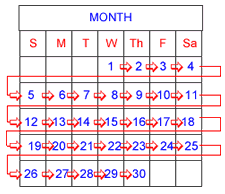Instruction to the teachers
- Prepare as many questions as possible and write them on the question cards. Questions can be as shown below.
i) Which month does the calendar sheet indicate?
ii) On which day has it started and on which day has it ended?
iii) How many Sundays are there in this month?
iv) How many Saturdays are there in this month?
v) Which day is 20th of this month?
vi) On which day does the 30th of this month fall?
vii) In any 2 x 2 square, consider the four numbers.
Add them diagonally. What do you observe?
How to play the Game
- Place all the question cards in a pile, face down.
- Ask all the players in each group to place their pawns in the square marked 1
- Ask the players to take turns in picking up a question card and answering the question.
if the answer is correct, the player rolls the dice and moves his pawn forward, by as many boxes as the number indicated on the dice
if the answer is wrong, he stays where he was..
in either case, the question card is put back into the pile.
- The counters are moved in ascending order of numbers, as shown.

The first child to reach the end of the month is the winner.
|